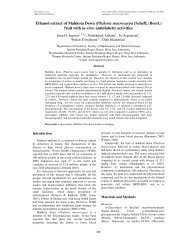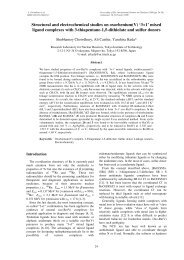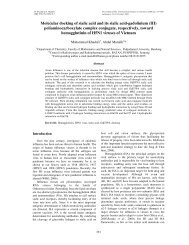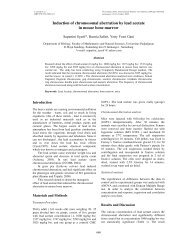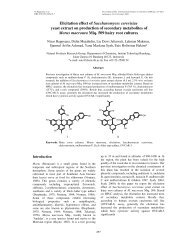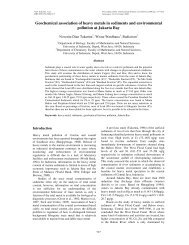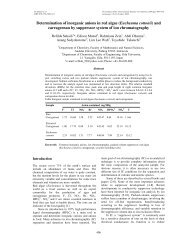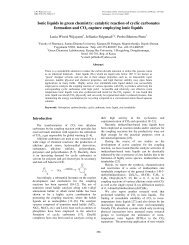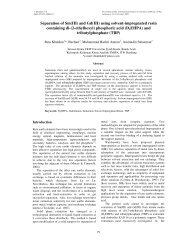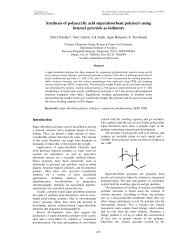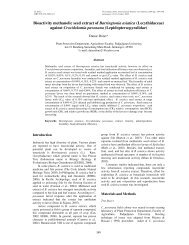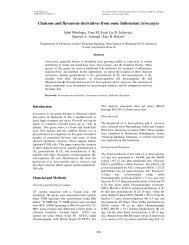Coumarin and steroid compound from stem bark of Kleinhovia ...
Coumarin and steroid compound from stem bark of Kleinhovia ...
Coumarin and steroid compound from stem bark of Kleinhovia ...
Create successful ePaper yourself
Turn your PDF publications into a flip-book with our unique Google optimized e-Paper software.
N.H. Soekamto et al. Proceeding <strong>of</strong> The International Seminar on Chemistry 2008 (pp. 231-234)Jatinangor, 30-31 October 2008J = 9.2 Hz, H-3), 7.60 (1H, d, J = 9.2 Hz, H-4), 6.84(1H, s, H-5), 6.92 (1H, s, H-8), 3.95 (3H, s, (OCH 3) );13 C NMR (Chlor<strong>of</strong>orm-D 6 , 500.2 MHz) δ: 161.67 (C-2), 150.41 (C-4’), 149.84 (C-6), 144.16 (C-7), 143.51(C-4), 113.58 (C-3), 111.66 (C-8’), 107.63 (C-5),103.35 (C-8), 56.57 (-OCH 3 ).Compound 2 was isolated as needles white crystal,with m.p. <strong>of</strong> 126 o C. The <strong>compound</strong> did not givephosphorescent under the UV lamp, The IR spectrum<strong>of</strong> 2 exhibited absorptions aliphatic (2956, 2918, 2848cm -1 ), -CH 2 (1462 cm -1 ) <strong>and</strong> -CH 3 (1377cm -1 )groups. The data indicated that <strong>compound</strong> 2 belong toterpenoid derivative. The sugestion was suported bynegatif result in the <strong>steroid</strong> test. 1 H NMR (CDCl 3 ,500.2 MHz) δ: 1.15 ppm (2H, dt, J =11.0; 3.65 Hz, H-1 eq ), 1.08, 1.84, 1.54, 3.51, 2.28, 2.22, 3.51, 1.98,1.94, 1.49, 0.91, 1.48, 2.00, 0.98, 1.58, 1.82, 1.07,1.34, 0.89, 1.65 ppm respectively (1H, m, for H-1 ax ,H-2eq, H-2 ax , H-3, H-4 eq , H-4 ax , H-5, 7eq <strong>and</strong> ax, 8, 9,11, 12eq, H-14, 15 eq , 16, 17, 20, 22 eq , 24, <strong>and</strong> 25 eq ),5.34 ppm (3H, d, J = 4.90 Hz, H-6), 0.67 <strong>and</strong> 1.00ppm (3H, s, H-18 <strong>and</strong> 19), 0.91 ppm (3H, d, J=6.1Hz), 1.14 ppm (2H, m, H-23), 0.82 <strong>and</strong> 0.80 ppmrespectively (3H, d, J = 6.7 Hz, for H-26 <strong>and</strong> 27),1.23 ppm (2H, m, H-28), 0.83 ppm (3H, t; J = 6.7 Hz,H-29); 13 C NMR (CDCl 3 , 500.2 MHz) δ: 140.8 (C-3),121.8 (C-6), 71.9 (C-2), 56.8 (C-15), 56.1 (C-17),50.2 (C-9), 45.9 (C-24), 42.4 (2C C-4 dan 14), 39.8(C-12), 37.3 (C-1), 36.6 (C-20), 36.2 (C-10),34.0 (C-22), 32.0 (2C, C-7 dan 8) 31.7 (C-2), 29.2 (C-25),28.4 (C-16), 26.1 (C-23), 24.4 (C-15), 23.1 (C-28),21.2 (C-11), 19.9 (C-26), 19.5 (C-27), 19.1 (C-19),18.9 (C-21), 12.1 (C-18), 12.0 (C-29).HOH 3 COOOHOH 3 CCH 3CH 3(1) (2)Figure 1 Scopoletin (1) <strong>and</strong> β-sitosterol (2)Results <strong>and</strong> DiscussionA coumarine derivative <strong>compound</strong> which hadbeen isolated for the first time From CHCl 3 fractionwas 7-hidroxy-6-methoxy coumarin (1). This<strong>compound</strong> was purified by coulumn chromatography<strong>and</strong> recrystallization <strong>and</strong> their structure wereH 3 CCH 3CH 3determined by spectral methods <strong>and</strong> comparison withthose reported in the literature.7-hidroxy-6-methoxy coumarin (1) was a whitepowder <strong>compound</strong> with m.p. <strong>of</strong> 182-184 o C. The UVspectrum <strong>of</strong> 1 showed absorption maxima at 228(3.98), 344 (4.40) nm, indicating the presence <strong>of</strong> anextended benzene chromophore. The IR spectrum <strong>of</strong> 1exhibited absorptions for hydroxyl (3338 cm -1 ),aliphatic (2924, <strong>and</strong> 2853 cm -1 ) <strong>and</strong> aromatic (, 1608,1566, 1508, 1464 cm -1 ) groups., -C=O (1701 cm -1 ),CH 3 (1376 cm -1 ), C-O (1291 cm -1 ).UV <strong>and</strong> IR data indicated that <strong>compound</strong> 1 iscoumarine derivative (Murray, et. al., 1982). The 1 HNMR spectrum <strong>of</strong> 1 showed two vinilic proton signalsat δ 6.27 ppm (1H, d, J = 9.2, H-3) <strong>and</strong> 7.60 ppm (1H,d, J = 9.2, H-4). Beside that 1 H NMR spectrum toshow two aromatic proton signals at δ 6.84 <strong>and</strong> 6.92ppm each 1H with multiplicity singlet assignable totetrasubstituted benzena moiety. Another informationin the 1 H NMR spectrum was the signal at δ 3.95 ppm(3H, s) for methyl –OCH 3 .The 13 C NMR spectrum <strong>of</strong> 1, showed that thereare ten signals including C carbonyl (C-2) at δ 161.67ppm, three oxycarbons at δ 144.16, 149.84 <strong>and</strong> 150.41ppm for C-6, C-7, <strong>and</strong> C-8a. And then other carbonatoms i.e. quarterner carbon C-4a, 6, 7, <strong>and</strong> 8a at δ111.66, 144.16, 149.84, <strong>and</strong> 150. 41 respectivelyassigned with the aid <strong>of</strong> HMBC measurements. It canbe proposed <strong>from</strong> these data that the structure <strong>of</strong> 1 is7-hidroxy-6-methoxy coumarin or scopoletin (Fig.2). The HMBC spectrum <strong>of</strong> 1, in particular, disclosedlong-range correlations between four the methynesignals at δ 6.27 ppm (H-3) with carbon signals at δ161.66 ppm (C-2), δ 7.60 ppm (H-4) with carbonsignals at δ 161.66 (C-2), 150.41 ppm (C-8a), δ 6.84ppm (H-5) with carbon signals at δ 149.84 (C-7),150.41 ppm (C-8a), δ 6.92 ppm (H-8) with carbonsignals at δ 144.16 (C-6), 149.84 (C-7), <strong>and</strong> δ 3.95ppm (H-9) with carbon signals at δ 144.16 (C-6) (Fig.3). Further support for structure 1 came <strong>from</strong>comparison <strong>of</strong> the NMR data with that <strong>of</strong> related<strong>compound</strong> (Soekamto et.al., 2001), isolated <strong>from</strong>Morus species (Table 1).Bioassay analysis to the <strong>compound</strong> 1 showmoderate activity against Artemia salina with LC 50 =569,64 µg/mL. Scopoletin was also isolated <strong>from</strong>Morinda citrifolia L. <strong>and</strong> it can be used asantihypertensive, antiinflamatory <strong>and</strong> antiallergenic(Rosa et.al., 2003), <strong>and</strong> can also be used as inhibitorprostagl<strong>and</strong>in synthetase (MH Farah <strong>and</strong> Sauelsson G,1992).232



